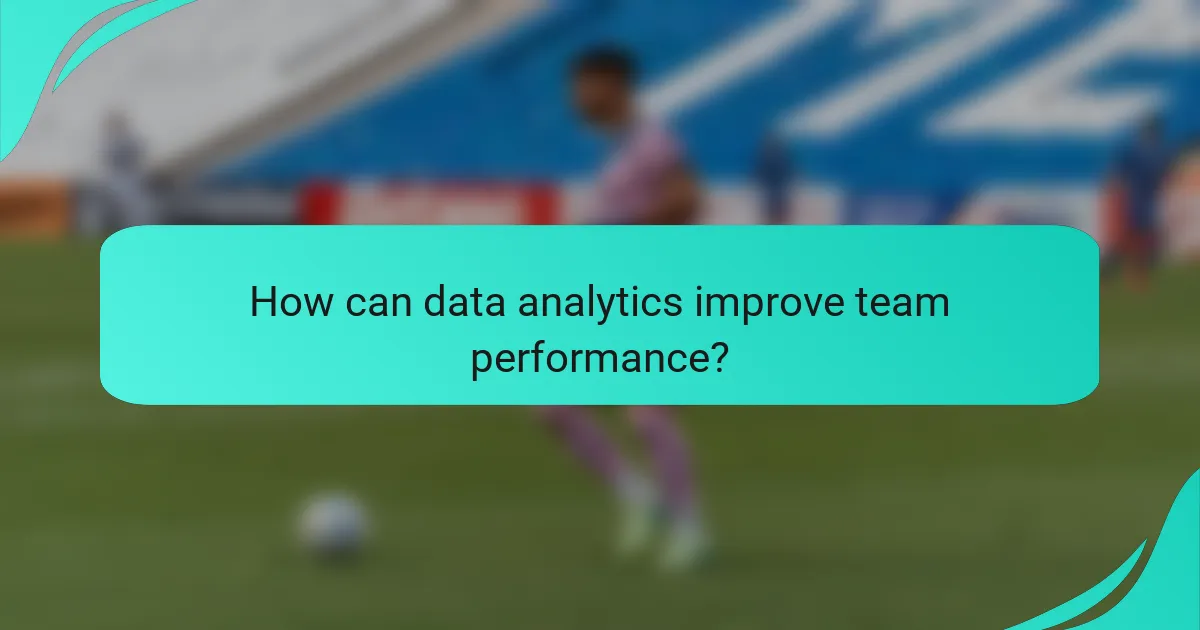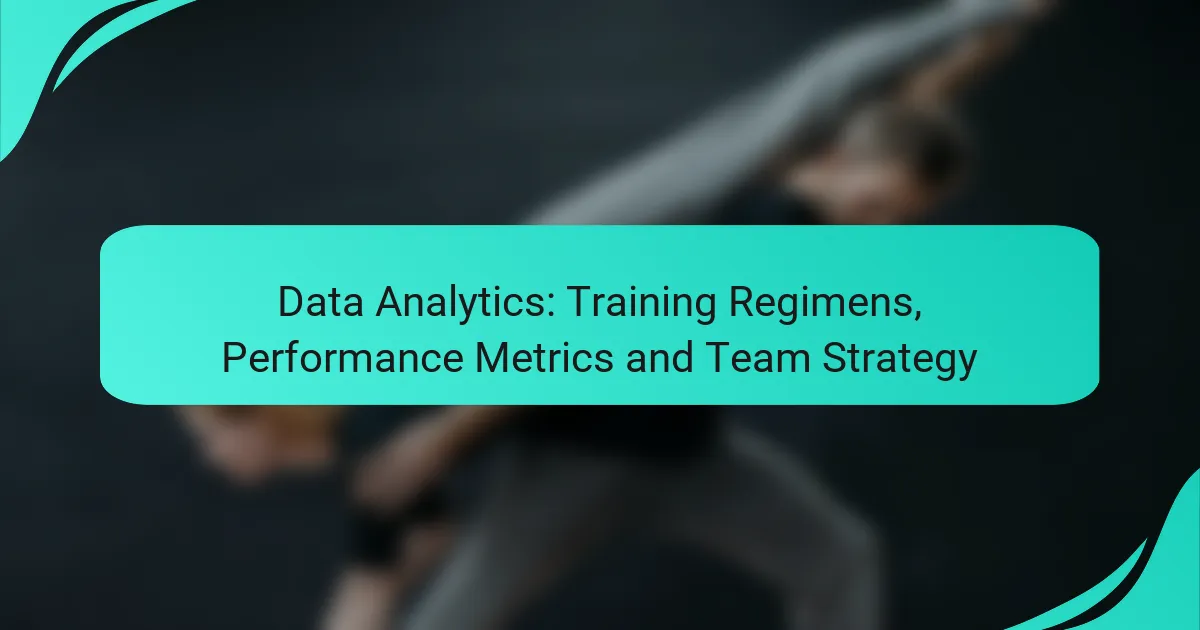Data analytics plays a crucial role in enhancing team performance by offering insights that drive informed decision-making and optimize resource allocation. Through effective training regimens and the careful tracking of performance metrics, teams can identify their strengths and weaknesses, ultimately leading to improved strategies and outcomes.

How can data analytics improve team performance?
Data analytics enhances team performance by providing insights that inform decision-making, streamline processes, and optimize resource use. By leveraging data, teams can identify strengths and weaknesses, leading to more effective strategies and improved outcomes.
Enhanced decision-making
Data analytics enables teams to make informed decisions based on empirical evidence rather than intuition. By analyzing historical performance metrics, teams can identify trends and patterns that guide future actions. For instance, a sports team might review player statistics to determine optimal lineups for upcoming matches.
To enhance decision-making, teams should prioritize key performance indicators (KPIs) relevant to their goals. Regularly reviewing these metrics can help teams adjust strategies in real-time, ensuring they remain competitive.
Increased efficiency
Implementing data analytics can significantly boost team efficiency by identifying bottlenecks and areas for improvement. For example, a marketing team can analyze campaign performance data to determine which channels yield the best return on investment, allowing them to allocate resources more effectively.
To maximize efficiency, teams should utilize automation tools that analyze data in real-time. This reduces manual effort and allows team members to focus on strategic tasks rather than data collection and analysis.
Better resource allocation
Data analytics aids in better resource allocation by providing insights into where resources are most needed. Teams can analyze workload data to ensure that personnel and budget are aligned with project demands, minimizing waste and maximizing impact.
For effective resource allocation, teams should regularly assess project performance and adjust resource distribution accordingly. This might involve reallocating funds from underperforming initiatives to those showing higher potential returns.
Improved collaboration
Data analytics fosters improved collaboration by providing a shared understanding of team performance and goals. When team members have access to the same data, they can align their efforts and work towards common objectives more effectively.
To enhance collaboration, teams should implement collaborative platforms that allow for real-time data sharing and communication. Regular meetings to discuss data insights can also help maintain alignment and encourage collective problem-solving.

What training regimens are effective for data analytics teams?
Effective training regimens for data analytics teams include hands-on workshops, online courses, mentorship programs, and certification programs. Each approach offers unique benefits that can enhance skills and improve team performance in data analytics.
Hands-on workshops
Hands-on workshops provide practical experience by allowing team members to work on real data projects in a collaborative environment. These sessions often focus on specific tools or techniques, enabling participants to apply their learning immediately.
When organizing workshops, consider the skill levels of participants and tailor the content accordingly. For example, a workshop on data visualization tools might be more beneficial for beginners than advanced users.
Online courses
Online courses offer flexibility and a wide range of topics for data analytics training. They can be self-paced or instructor-led, covering everything from basic statistics to advanced machine learning techniques.
When selecting online courses, look for those that provide practical assignments and projects. Platforms like Coursera or edX often feature courses from reputable institutions, which can enhance credibility and learning outcomes.
Mentorship programs
Mentorship programs pair less experienced team members with seasoned professionals, fostering knowledge transfer and skill development. This one-on-one guidance can help mentees navigate complex analytics challenges and gain insights from real-world experiences.
To implement a successful mentorship program, establish clear goals and expectations for both mentors and mentees. Regular check-ins can help track progress and address any challenges that arise during the mentoring process.
Certification programs
Certification programs validate the skills and knowledge of data analytics professionals, often enhancing their career prospects. These programs typically require passing an exam and may cover various topics, including data management, analytics tools, and statistical methods.
When considering certification, research the most recognized programs in the industry, such as those offered by Microsoft or SAS. Ensure that the certification aligns with your team’s goals and the specific analytics tools you use.

What performance metrics should be tracked?
Tracking performance metrics is essential for evaluating the effectiveness of data analytics initiatives. Key metrics provide insights into team efficiency, project success, and overall return on investment.
Key Performance Indicators (KPIs)
Key Performance Indicators (KPIs) are quantifiable measures that help assess the success of a data analytics strategy. Common KPIs include data processing speed, user engagement rates, and accuracy of insights generated. Selecting KPIs should align with specific business goals to ensure relevance.
For example, if the goal is to improve customer satisfaction, tracking metrics like Net Promoter Score (NPS) or customer retention rates can provide valuable insights. Regularly reviewing these KPIs allows teams to adjust strategies as needed.
Return on Investment (ROI)
Return on Investment (ROI) measures the financial return generated from data analytics efforts relative to the costs incurred. Calculating ROI involves comparing the monetary benefits derived from analytics projects against the total expenses, including software, personnel, and training costs.
A positive ROI indicates that the data analytics initiatives are yielding profitable outcomes. Businesses should aim for an ROI of at least 3:1, meaning for every dollar spent, three dollars should be gained. Regular assessments can help in optimizing resource allocation.
Data accuracy rates
Data accuracy rates reflect the correctness of the data being analyzed. High accuracy is crucial for making informed decisions, as inaccurate data can lead to misguided strategies. Organizations should aim for data accuracy rates above 95% to ensure reliability.
To improve accuracy, implement regular data validation checks and cleansing processes. Establishing a culture of data stewardship among team members can also enhance overall data integrity.
Project completion times
Project completion times indicate how efficiently a data analytics project is executed. Tracking these times helps identify bottlenecks and areas for improvement within the workflow. Aim for project timelines that align with industry standards, which often range from a few weeks to several months, depending on complexity.
To optimize completion times, utilize agile methodologies that promote iterative progress and regular feedback. Setting clear milestones can also help keep projects on track and ensure timely delivery of insights.

How to select the right data analytics tools?
Selecting the right data analytics tools involves evaluating their user-friendliness, integration capabilities, scalability, and customer support options. These factors ensure that the tools align with your team’s needs and can effectively support your data-driven decision-making processes.
Evaluate user-friendliness
User-friendliness is crucial for ensuring that team members can efficiently navigate and utilize the analytics tools. Look for intuitive interfaces and clear documentation that facilitate quick onboarding and minimize the learning curve.
Consider tools that offer visual dashboards and drag-and-drop functionalities, as these features can significantly enhance usability. A user-friendly tool can lead to higher adoption rates among team members, ultimately improving productivity.
Assess integration capabilities
Integration capabilities determine how well the analytics tools can work with your existing systems and data sources. Choose tools that seamlessly connect with popular databases, CRM systems, and other software your team uses.
Evaluate whether the tool supports APIs or pre-built connectors, as these can simplify data import and export processes. A tool with strong integration features can streamline workflows and enhance data accuracy across platforms.
Consider scalability
Scalability is essential for accommodating growth in data volume and user numbers. Select tools that can handle increasing workloads without sacrificing performance or requiring significant upgrades.
Look for options that offer tiered pricing plans or modular features, allowing you to expand capabilities as your needs evolve. This flexibility ensures that your analytics solutions can grow alongside your organization.
Review customer support options
Reliable customer support is vital for resolving issues and maximizing the effectiveness of your analytics tools. Investigate the support channels available, such as live chat, email, or phone assistance, and their hours of operation.
Additionally, check for online resources like knowledge bases, tutorials, and community forums. Strong customer support can significantly reduce downtime and enhance your team’s ability to leverage the analytics tools effectively.

What are the best practices for data analytics team strategy?
Effective data analytics team strategy hinges on clear objectives, collaboration, and continuous evaluation of performance metrics. Implementing best practices can significantly enhance team productivity and the quality of insights generated.
Define clear objectives
Establishing clear objectives is crucial for guiding a data analytics team’s efforts. Objectives should be specific, measurable, achievable, relevant, and time-bound (SMART). This clarity helps team members understand their roles and the expected outcomes of their work.
When defining objectives, consider the overall business goals and how data analytics can support them. For instance, if a company aims to increase customer retention, the analytics team might focus on analyzing customer behavior and identifying at-risk segments.
Regularly review and adjust these objectives based on evolving business needs and insights gained from data analysis. This adaptability ensures the team remains aligned with organizational priorities and can pivot as necessary.
